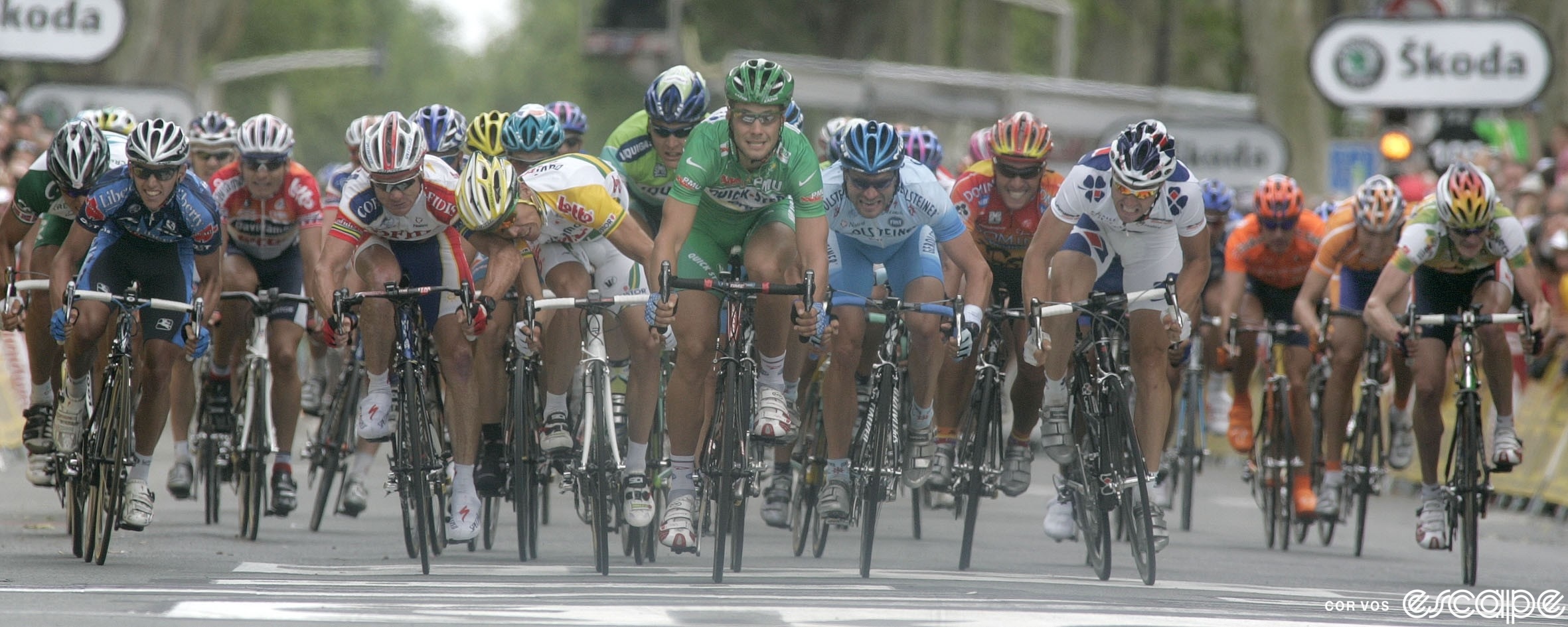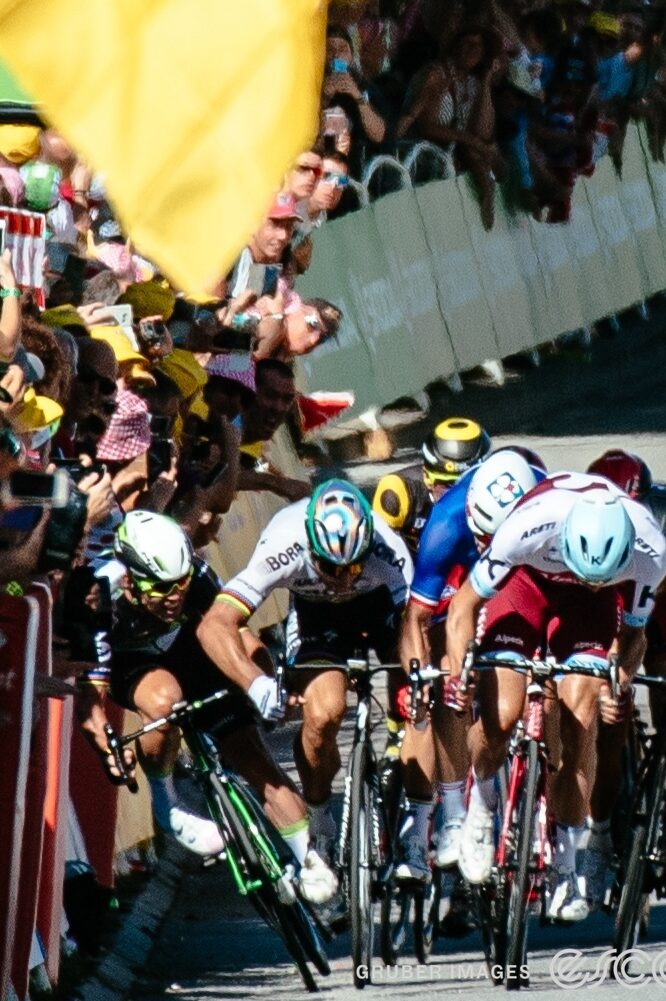As Mark Cavendish gears up for a historic run at the outright record for Tour de France stage wins, it’s worth remembering that were it not for one fateful finish, he might have gotten that 35th victory years ago.
On stage 4 of the 2017 edition, fireworks flew on a chaotic finish in Vittel. As Lotto led it out for Andre Greipel, Arnaud Démare opened his sprint and came around stage 3 winner Peter Sagan as the group drifted right toward the barriers. Cavendish, on the wheel, attempted to follow, but Sagan closed the door, squeezing Cavendish against the barriers. The Manxman opened his mouth in a shout as contact was made before crashing heavily to the ground.
Cavendish got up slowly and rolled over the line in 186th place, but x-rays showed a fractured right scapula, and he would not start stage 5. Barring the 2014 edition, Cavendish had won at least one stage of the Tour every year since 2008. But fighting Epstein-Barr and then depression in 2017, Cavendish had no idea it would be five years until he would win another Tour stage. The crash was equally pivotal for the sport and the intricate, ill-understood rules around rider behavior in bunch finishes.

Almost immediately after the finish, the UCI commissaires panel relegated Sagan to last place in his group. Then came a shock: “We have decided to disqualify Peter Sagan from the 2017 Tour de France after the tumultuous sprint here in Vittel, where he endangered several riders, including Mark Cavendish,” said race jury president Philippe Marien in a later statement. Sagan, the five-times-running winner of the Tour’s points competition, was out of the race altogether.
The decision was immediately controversial. Had Sagan purposely stuck out his elbow to block Cavendish? Arguing for the defense, Sagan’s fans said he was merely following Démare and was using his elbow to counterbalance as Cavendish initiated contact from behind, trying to squeeze through a gap that wasn’t there. But it crystallized a question: what does a rider have to do to get thrown out of a race? Who decides whether an act merits that punishment or a lighter one? And how?
What the rule says
UCI rules on bike racing can be legendarily squishy, written in a way that allows almost every possible interpretation to reach a desired result. But the rule on deviating from a line in sprints is – at first glance – a paragon of clarity about what is not allowed in intermediate or final sprints:
“Deviation from the chosen line that obstructs or endangers another rider or irregular sprint (including pulling the jersey or saddle of another rider, intimidation or threat, blow from the head, knee, elbow, shoulder, hand, etc.).”
UCI Table of Incidents 5.1

As for penalties, in a WorldTour event those actions bring a CHF 500 fine (about €520) and relegation to the last place in the rider’s group. In stage races like the Tour, there is also a 25% penalty in the points classification. But crucially, for both multi-day and one-day events, the rules say that “in serious cases and/or in cases of repeated infringement and/or aggravating circumstances or if an infringement offers an advantage, the commissaire’s panel may eliminate or disqualify a rider.”
Again, at first glance that seems clear. But wait: what are “serious cases” or “aggravating circumstances”? How does the panel decide an infringement offered an advantage?
Degrees of punishment
To answer that, you have to dive deep into the UCI’s training guide for road commissaires, a dense, 300-page manual with instructions on every aspect of the commissaire’s panel’s wide-ranging remit. There are sections covering everything from ensuring riders have their race numbers and timing transponders properly attached to monitoring the conduct of follow vehicles in time trials.
The panel for road races is made up of multiple members with various roles: a president, several appointed general and deputy commissaires, a finish judge who processes results, motorcycle commissaires who supervise in-race incidents, and timekeepers.
UCI international commissaires are not full-time UCI employees but rather individual contractors (586 men and 69 women at last count) who have taken training courses and passed the international commissaire’s exam on one or more of the sport’s various disciplines. Basically, they’re experts on the rules of bike racing. The training guide is their bible.
In the section on penalties, you’ll find this quadrant chart detailing the matrix of in-race actions and relevant penalties (note that these apply not only to riders, but all accredited personnel in the race caravan too).

According to an active UCI road commissaire who spoke to Escape Collective, that chart is intended to guide the panel in its work while allowing some interpretive room. “There is no guidance on tolerances that a rider could deviate from,” said the commissaire, who preferred to remain anonymous. Race situations are so fluid, and so different from case to case, that it’s impossible to assign, say, sprinting lanes of a certain width that a rider must stay in.
That matrix features both mitigating and aggravating factors that help the commissaires panel determine the severity of punishment. Did a rider swerve unexpectedly in a sprint because a fan waved a sign in his face? That would suggest no penalty even if the deviation disrupted the sprint. Was another rider injured in a crash as a result of even a forced deviation? That might point commissaires to a warning.
How the commissaires decide
While many factors rely on observable facts, some are highly subject to interpretation, most notably the one that suggests a DSQ is the appropriate penalty: was the action intentional?
When it comes to that, our source said, “guidance isn’t published as there could be a number of contributory factors.” Basically, the UCI wants to give commissaires latitude to take the whole situation into account. But that’s not to say the organization is completely hands-off.
“Particularly at WorldTour level where the decision taken can carry a significant financial impact for the rider or team, the UCI staff are on hand to discuss the incident and the associated penalty before a decision is communicated,” the commissaire said. Sometimes that leads to a delay (the belated Sagan DSQ as one example).
Commissaires can use a range of tools and evidence to arrive at any decision, but TV images are among the most crucial. “Particularly in those races where helicopter shots are available,” said the commissaire, those shots can provide clarity and important context, like “observing the speed at which the trailing rider is gaining and about to overtake when the deviation/crash occurs.”
The trick is how to make a decision when that video evidence doesn’t exist; as the commissaire pointed out, many UCI-rated events have either minimal or no broadcast footage to work with. In those circumstances and absent independent witnesses, “the benefit of the doubt will have to be given.”

Tour de France Daily
Enter your email address to get our daily Tour de France news delivered directly to your inbox!
Get our daily Tour de France news delivered directly to your inbox!
How the 2017 crash changed things
It’s hard to overstate the importance of video footage, and how it can change the understanding of an event. Take that controversial Sagan DSQ at the 2017 Tour. After his initial appeal for reinstatement was denied, Sagan lodged a legal protest against the UCI.
Months after the fact, and just before a Court of Arbitration for Sport hearing was to be held on the matter, the UCI settled with Sagan and admitted that commissaires had gotten the call wrong, citing video evidence which was not available to the commissaires at the time. “The crash was an unfortunate and unintentional race incident and the UCI commissaires made their decision based on their best judgment in the circumstances,” the UCI said in a December 2017 press release announcing the closure of the case.
For the 2018 season, the UCI trialled a video support commissaire role at select WorldTour races and made it a permanent feature for the entire calendar the following year. A special van at the finish is equipped with, essentially, a small TV production studio, with computers and multiple monitors for viewing up to eight feeds simultaneously: motorbike and helicopter cameras; finish line cameras, including the elevated “cherry picker” vantage point; and photo-finish cameras. All feeds must be in high-definition video format, and the viewing software is capable of slow-motion and zoom-in analysis. The video support commissaire and panel members – who are some of the only people allowed in the van – can even check social media feeds for different angles of footage posted by fans, all to assist the commissaires panel in their decision-making. But that system isn’t available at all races below the WorldTour level.
Sprinting will always be a chaotic and explosive part of a race, and there is still ambiguity and controversy around penalties, including the always-consequential disqualification. But with new tools including the video van and a yellow card system that will debut next season, commissaires increasingly have the capability to get the call right.
What did you think of this story?



